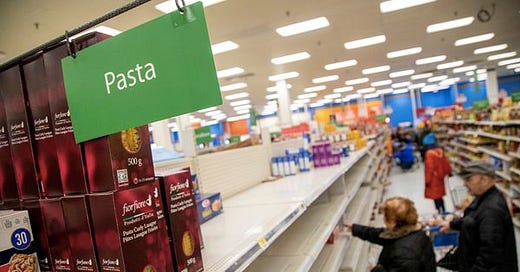Issue 37: Food security in a pandemic
As COVID-19 pandemic threatens our supply chains, to guarantee food security our policy response must include the pandemic's effect on consumers, on labour, and on poor or vulnerable populations
Today’s briefing is by Aurélie Harou (AH), who is an assistant professor of agricultural and resource economics in the Department of Natural Resource Sciences at McGill University.

EMPTY SUPERMARKET SHELVES have now become a common-place experience for many, if not all of us. This experience likely caused anxiety and fear, and you may have asked yourself: will it continue to be difficult to find products in supermarkets? Will I be able to afford the foods I usually purchase? How are food shortages affecting others in my community? How will the global food supply be affected by this pandemic?
Without knowing how all of this will unfold, it is hard to predict the future of the food supply. However, a current examination of COVID-19’s effects on food supply and demand reveals that targeted policies can support global food security by helping consumers afford food and suppliers adapt to a shifting food supply chain and possible labor disruptions.
Supermarket purchasing binges and shortages began with toilet paper and hand sanitizer, which set off a wave of panic buying of easily stored goods, such as bread, grains, nuts, and canned/frozen goods. Rice sales increased by more than 50% during this period compared to the incremental 2% increase last year.
Such panic buying may be driven by rational fears of wanting to prepare for an uncertain future, but may also result from other psychological influences. The more empty shelves you see, the more a ‘herd effect’ may lead you to stock up on a particular item the next time it becomes available. Furthermore, the food shopping experience may help you regain some feeling of control in this uncertain environment.
Consumer preferences are also changing as buyers turn to processed junk foods for various reasons, including the need for comfort, boredom, convenience, or picking up a new hobby such as cooking or baking. Examples include Campbell soups sales soaring 59% from last year, and massive demand for flour, Cheerios, and pancakes mix that have increased General Mills’ profits.
When considering changing food demands, most alarming is the increasing unemployment rate and its effect on demand. Families whose members have lost their jobs are worrying about where their next meal will come. School closures mean that up to 30 million US children who usually receive school lunches under the US National School Lunch Program no longer have access to them unless their districts allow for lunch pick-ups. Food banks are struggling to stay afloat as consumers queue for food, while donations and volunteers diminish.
COVID-19 has changed the way we feed ourselves. Food demand in supermarkets has increased as dining out options are reduced to ordering delivery or takeout. With it, the shift in demand for food from restaurants, school cafeterias and college campuses to supermarkets has forced supply chains to quickly adapt. Many farms have been forced to destroy tens of millions of pounds of fresh food that they can no longer sell to their traditional buyers. Dairy Farmers of America, for example, estimates that their members are destroying as much as 5% of their milk supply as demand has tanked from coffee shop and school closures. While some farmers donate parts of their surplus harvests to food banks, perishable food donations are limited and the cost of harvesting, processing and then transporting foods to the banks puts further financial strain on these farms.
Perhaps the biggest way that COVID-19 threatens our food supply is through its effect on labour. Social distancing and self-isolation are difficult to practice in farmworker communities, especially in production and distribution channels where workers operate machinery shoulder-to-shoulder. Meat plants and slaughterhouses have recently been revealed to be a hotspot for virus infection, resulting in the need to shut down several beef, pork and chicken processing plants across North America. For example, the number of cattle slaughtered has dropped 22% from the same time last year. Finally, there have been labour shortages across Canada, the US and Europe due to restrictions on migration. Large farms who often rely on workers from other countries to help during harvest, are coming up short on labour.
While COVID-19 is said to be non-discriminatory, its indirect effects, like food security, are not. Poorer and more vulnerable communities and populations here and abroad are and will continue to be worst-hit. For others, intermittent food supply shortages and price hikes may require temporary substitution of products. Policy makers can help ensure food security by helping consumers who have lost their jobs, such as the Canada Emergency Response Benefit. In the US, President Trump has issued an executive order to keep meat processing plants open to prevent meat shortages. But policies protecting workers must also be enacted as they face increased risks. Finally, as we worry about food security at home, we should not ignore communities abroad as the UN World Food Program warns that twice as many people worldwide will go hungry next year due to COVID-19. (AH)
Further viewing: Prof. Harou gave a webinar on pandemic food security for the Max Bell School of Public Policy

Listen: Haruki Marukami is scheduled to DJ a special “Stay Home” radio special
Follow: Say this three times fast: Sarah Cooper’s Trump-karaoke TikTok
Treats: You’re a grownup. You can make Rice Krispie Squares anytime you like
___
Policy for Pandemics is produced and edited by Andrew Potter and co-edited by Charlotte Reboul and Paisley Sim (bios here) If you have any feedback or would like to contribute to this newsletter, please send an email to andrew2.potter@mcgill.ca



